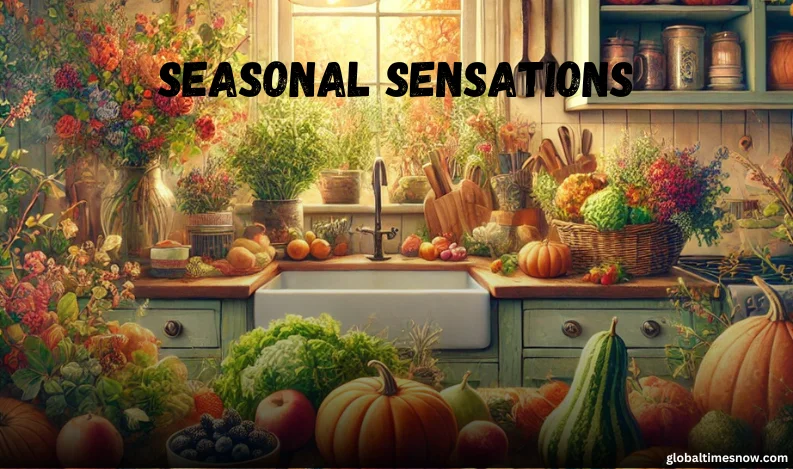Every season brings its own bounty of fresh, flavorful ingredients that inspire home cooks, chefs, and food lovers worldwide. Cooking with seasonal produce not only enhances the taste and nutritional value of meals but also supports local farmers and promotes sustainable food practices. By embracing seasonal cooking, you can enjoy ingredients at their peak freshness, explore diverse flavors throughout the year, and create dishes that truly celebrate nature’s cycles. Whether it's warming root vegetable soups in winter, refreshing berry salads in summer, or earthy mushroom risottos in autumn, every season provides an opportunity to make cooking more exciting and flavorful.
This article explores the importance of seasonal eating, the best ingredients for each season, seasonal cooking techniques, and tips for making the most of nature’s bounty all year long.
1. Why Cooking with Seasonal Ingredients Matters
Eating seasonally isn’t just a culinary trend—it has tangible benefits for your health, the environment, and the economy.
A. Better Flavor and Nutrition
Seasonal produce is harvested at its peak, meaning it is fresher, juicier, and more flavorful compared to produce that has been stored for months.
- Example: Tomatoes ripened in the summer sun are naturally sweeter and juicier than off-season, store-bought tomatoes.
- Leafy greens like kale and spinach are at their most nutrient-dense in the colder months.
B. Supports Local Farmers and Communities
Buying seasonal foods from farmers' markets and local producers helps support regional agriculture, ensuring that farmers earn fair prices for their crops.
- Seasonal eating strengthens local food economies and helps reduce reliance on imported, mass-produced goods.
C. Environmentally Friendly
Eating seasonal foods reduces the carbon footprint of your meals by cutting down on long-distance food transportation and excessive packaging.
- Locally sourced produce requires fewer preservatives, less refrigeration, and less transportation fuel compared to imported foods.
D. Budget-Friendly Eating
Seasonal fruits and vegetables are often more affordable since they are abundant when they are in season.
- Example: Pumpkins and squash are cheaper in autumn, while strawberries and cherries are more affordable in summer.
By cooking seasonally, you can enjoy the freshest, most affordable, and eco-friendly meals all year round.
2. The Best Ingredients for Each Season
Each season offers a unique palette of ingredients that bring different flavors, textures, and colors to your plate. Here’s what to look for in each season:
A. Spring: Fresh and Green
Spring is a time of renewal and light, fresh flavors. After the colder months, leafy greens, crisp vegetables, and tender fruits come into season.
Best Spring Ingredients:
- Vegetables: Asparagus, peas, artichokes, radishes, leeks
- Fruits: Strawberries, rhubarb, citrus (lemons, grapefruits)
- Herbs: Chives, mint, parsley
Spring Recipe Idea: Lemon Garlic Asparagus with Parmesan – Roasted asparagus with zesty lemon, olive oil, and shaved parmesan for a fresh, vibrant dish.
B. Summer: Bright, Juicy, and Vibrant
Summer is the peak season for fruits and vegetables, with plenty of sweet, juicy, and colorful produce.
Best Summer Ingredients:
- Vegetables: Tomatoes, zucchini, bell peppers, corn, cucumbers
- Fruits: Watermelon, peaches, berries, mangoes, cherries
- Herbs: Basil, cilantro, thyme
Summer Recipe Idea: Watermelon & Feta Salad with Mint – Sweet watermelon pairs beautifully with tangy feta and refreshing mint for a cooling summer dish.
C. Autumn: Warm, Earthy, and Comforting
As temperatures cool, heartier, earthy vegetables and warming spices become the stars of seasonal cooking.
Best Autumn Ingredients:
- Vegetables: Pumpkins, squash, mushrooms, beets, carrots
- Fruits: Apples, pears, figs, cranberries
- Herbs & Spices: Sage, cinnamon, nutmeg
Autumn Recipe Idea: Roasted Butternut Squash Soup – A creamy, spiced soup made with roasted butternut squash, garlic, and a touch of nutmeg.
D. Winter: Hearty and Nourishing
Winter is a time for rich, warming dishes made with root vegetables, dark leafy greens, and preserved foods.
Best Winter Ingredients:
- Vegetables: Potatoes, cabbage, Brussels sprouts, parsnips
- Fruits: Oranges, pomegranates, kiwis, persimmons
- Herbs & Spices: Rosemary, cloves, black pepper
Winter Recipe Idea: Slow-Cooked Beef Stew with Root Vegetables – A rich, comforting stew with carrots, potatoes, and tender beef.
3. Cooking Techniques for Seasonal Ingredients
Cooking methods should highlight the natural flavors and textures of seasonal produce.
Spring & Summer Cooking Methods:
-
Grilling – Enhances the sweetness of summer vegetables like corn and bell peppers.
- Blanching & Steaming – Keeps leafy greens and delicate vegetables crisp and fresh.
- Raw Preparations – Salads, fruit bowls, and ceviches make the most of summer’s freshness.
Autumn & Winter Cooking Methods:
-
Roasting & Baking – Brings out the natural sweetness of root vegetables.
- Slow Cooking & Braising – Ideal for hearty stews and soups that warm you up in winter.
- Fermentation & Pickling – Preserves autumn vegetables for winter consumption.
By choosing seasonally appropriate cooking techniques, you can maximize flavor and create dishes that truly reflect the essence of each season.
4. Tips for Making the Most of Seasonal Produce
A. Plan Meals Around Seasonal Availability
-
Check local farmers' markets or seasonal produce guides before meal planning.
- Incorporate seasonal ingredients into your daily meals instead of relying on imported foods.
B. Preserve Seasonal Flavors for Later
-
Freezing: Freeze berries, chopped vegetables, and herbs to use in off-seasons.
- Pickling: Extend the shelf life of cucumbers, onions, and beets by pickling them.
- Canning: Preserve summer fruits like peaches and tomatoes for winter.
C. Experiment with New Flavors
-
Try a new seasonal ingredient each month to diversify your cooking.
- Combine ingredients across seasons, like roasted winter squash with summer spices.
D. Reduce Food Waste
-
Use vegetable scraps for homemade broths and soups.
- Make smoothies with overripe fruits instead of throwing them away.
- Store produce properly to keep it fresh longer.
By following these tips, you can extend the benefits of seasonal eating and make every meal more delicious and sustainable.
5. The Future of Seasonal Cooking: What’s Next?
As more people become aware of sustainability, health, and local food movements, seasonal cooking is becoming a major trend in modern kitchens.
Emerging Seasonal Food Trends:
-
Farm-to-table dining – More restaurants are emphasizing local, seasonal menus.
- Urban farming & rooftop gardens – Growing fresh produce in cities.
- Seasonal meal subscriptions – Delivery services providing local, in-season produce.
- Innovative preservation methods – Fermented and freeze-dried seasonal foods becoming more popular.
As we move toward a more sustainable and mindful approach to food, embracing seasonal eating will play an even greater role in our daily lives.
Conclusion: Celebrating Each Season in Your Kitchen
Seasonal cooking is about embracing nature’s cycles, enjoying food at its peak, and creating flavorful, fresh meals year-round. By choosing seasonal produce, experimenting with different cooking methods, and preserving ingredients, you can elevate your home cooking while making a positive impact on your health and the environment.
So the next time you cook, celebrate the season’s best offerings and let nature’s flavors guide your meals!
You may also like:-














